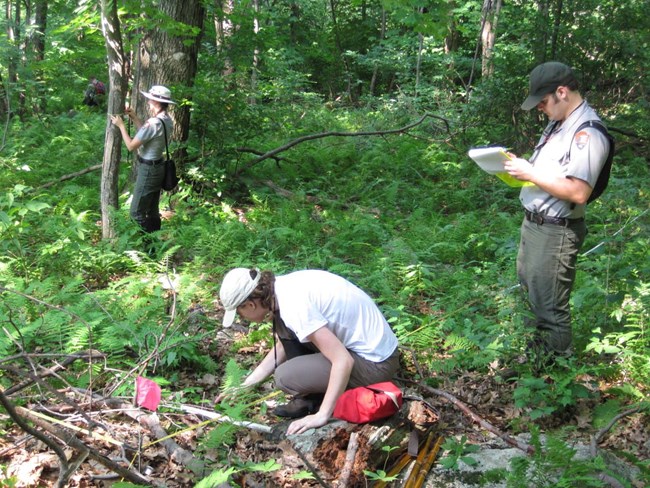
NPS / Wendy Hochstedler
Importance and Issues
Forests are the dominant ecosystem in the Blue Ridge physiographic province. Forests are a logical choice for monitoring because they represent a large key ecosystem component. This vegetation component forms the matrix upon which many other organisms depend, and is an essential visual component of the landscape. Understanding forest status and trends is fundamental to knowing the condition of natural resources.
Long- term forest monitoring provides information on how the forests are changing over time. Many factors such as gypsy moth, hemlock woolly adelgid, invasive exotic plants, storms, and other disturbances are constantly impacting our forests. Long-term forest monitoring allows us to describe the forest's composition, and then quantify the way the forest composition and regeneration respond to disturbance over time.
Monitoring forests over time also provides early warnings of new forest threats such as new invasive plants. The fire fuels monitoring included with the forest monitoring program also aids the fire program by providing information used in fire behavior models critical to making proper decisions when fighting wildfire.
Monitoring Objectives
- Determine the status and trends in the composition, abundance, and structure of forest canopy and understory woody species.
- Determine the status and trends in the composition and abundance of invasive exotic plants and forest herbs.
- Determine the status and trends in the abundance of forest woody debris and composition of forest soils.
Source: NPS DataStore Saved Search 685 (results presented are a subset). To search for additional information, visit the NPS DataStore.
Periodically, we publish reports that describe what we are learning in the field. These monitoring reports are more in-depth than resource briefs and include data analysis and a discussion of our findings.
Source: NPS DataStore Saved Search 698 (results presented are a subset). To search for additional information, visit the NPS DataStore.
Protocols describe how we monitor. They include a descriptive narrative of what we monitor and why, our field methods, how we analyze and manage our data, and more. All of our protocols are peer reviewed.
Source: NPS DataStore Saved Search 708 (results presented are a subset). To search for additional information, visit the NPS DataStore.
For More Information
Contact Wendy Cass, Shenandoah NP Botanist
Last updated: December 15, 2020
